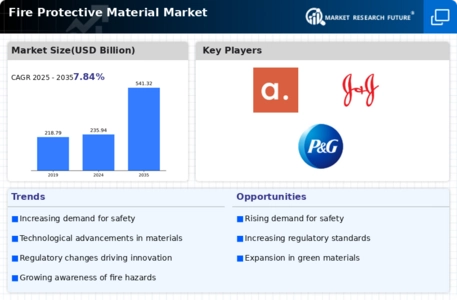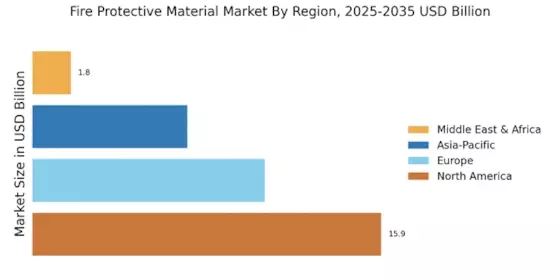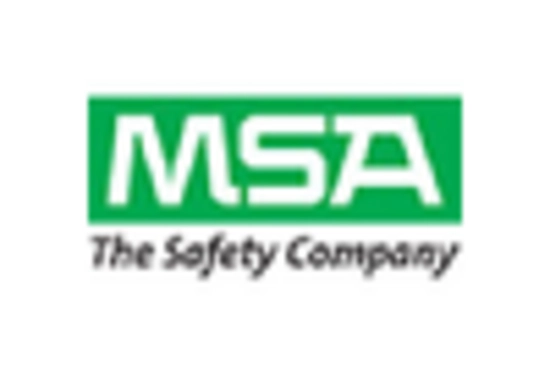Technological Advancements
Technological advancements play a pivotal role in shaping the Fire Protective Material Market. Innovations in material science have led to the development of more effective and efficient fire-resistant materials. For instance, the introduction of nanotechnology in fire protective coatings has significantly improved their performance, offering enhanced thermal resistance and durability. The market is witnessing a shift towards smart materials that can respond to fire conditions, thereby providing real-time protection. In 2025, the market for advanced fire protective materials is expected to expand, driven by these technological innovations. Companies are increasingly investing in research and development to create products that not only meet safety standards but also offer additional functionalities, such as self-extinguishing properties. This trend indicates a promising future for the Fire Protective Material Market as it adapts to the demands of modern construction and safety requirements.
Growth in Industrial Sector
The Fire Protective Material Market is poised for growth, particularly due to the expansion of the industrial sector. Industries such as manufacturing, oil and gas, and chemical processing are increasingly recognizing the importance of fire protection measures. As these sectors expand, the demand for fire protective materials is expected to rise correspondingly. In 2025, the industrial sector is projected to grow by approximately 4%, which will likely lead to increased investments in fire safety solutions. Companies are focusing on implementing comprehensive fire protection strategies to mitigate risks associated with fire hazards. This trend is driving innovation in the development of specialized fire protective materials tailored for industrial applications. As a result, the Fire Protective Material Market is likely to experience robust growth, fueled by the industrial sector's commitment to safety and compliance.
Rising Construction Activities
The Fire Protective Material Market is experiencing a surge due to increasing construction activities across various sectors. As urbanization accelerates, the demand for fire-resistant materials in residential, commercial, and industrial buildings is on the rise. In 2025, the construction sector is projected to grow by approximately 5% annually, which directly correlates with the heightened need for fire protective materials. This growth is driven by the necessity to comply with stringent safety regulations and standards that mandate the use of fire-resistant materials. Consequently, manufacturers are innovating to develop advanced fire protective solutions that meet these evolving requirements. The integration of fire protective materials in new constructions not only enhances safety but also adds value to properties, making it a critical driver in the Fire Protective Material Market.
Increased Awareness of Fire Safety
The Fire Protective Material Market is significantly influenced by the growing awareness of fire safety among consumers and businesses. As incidents of fire-related disasters continue to make headlines, there is a heightened focus on implementing effective fire protection measures. This awareness is prompting both residential and commercial property owners to invest in fire protective materials to safeguard lives and assets. In 2025, the market is expected to benefit from this trend, as more stakeholders recognize the importance of fire safety compliance. Educational campaigns and government initiatives aimed at promoting fire safety standards are further driving this demand. Consequently, manufacturers are responding by offering a wider range of fire protective products that cater to diverse needs, thereby enhancing their market presence in the Fire Protective Material Market.
Regulatory Frameworks and Standards
The Fire Protective Material Market is heavily influenced by the establishment of stringent regulatory frameworks and standards. Governments and regulatory bodies are increasingly implementing laws that mandate the use of fire-resistant materials in construction and manufacturing processes. These regulations are designed to enhance safety and reduce the risk of fire hazards in various environments. In 2025, compliance with these regulations is expected to drive demand for fire protective materials, as businesses seek to avoid penalties and ensure the safety of their operations. The market is likely to see a rise in certifications and testing requirements for fire protective products, which will further stimulate innovation and quality improvements among manufacturers. This regulatory landscape is a crucial driver for the Fire Protective Material Market, as it compels stakeholders to prioritize fire safety in their operations.


















Leave a Comment